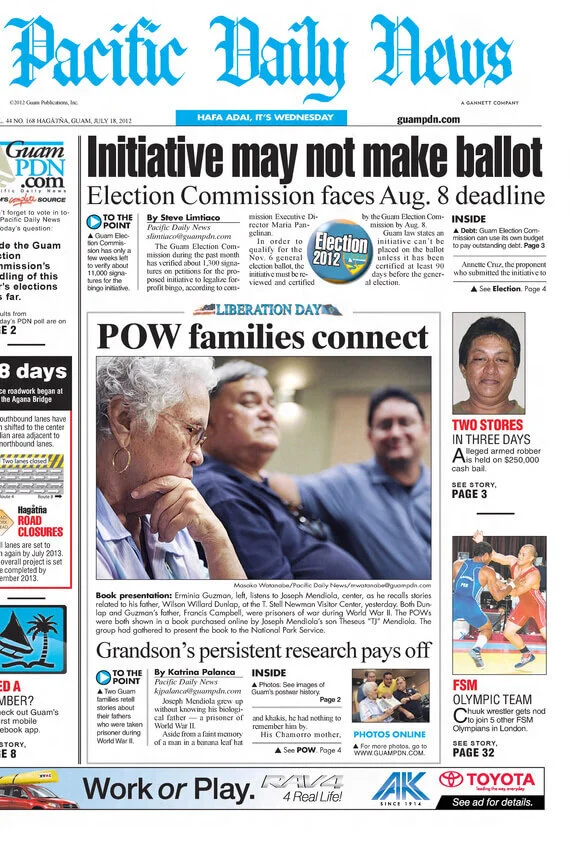Prisoner of War Families Connect
Grandson’s Persistent Research Pays Off
Joseph Mendiola grew up without knowing his biological father – a prisoner of World War II. Aside from a faint memory of a man in a banana leaf hat and khakis, he had nothing to remember him by.
His Chamorro mother, Lourdes Mendiola, was six months pregnant with Joseph when the Japanese took his American father, Wilson Willard Dunlap, as a prisoner of war during World War II. Dunlap, a sailor in the US Navy, was sent to Zentsuji POW Camp in Japan.
Lourdes Mendiola was told that no one would survive the camp.
On March 15, 1942, three months after the Japanese landed, she gave birth to a baby boy. During the turmoil and chaos of the invasion, the newborn had a couple of brushes with death. “My mom said I was a miracle child,” said Joseph Mendiola.
Although life during the war was difficult, Lourdes Mendiola slowly settled down, remarried and had more children. She grew accustomed to this new life and did not expect what would happen next.
A couple of months after the war ended, Dunlap returned to Guam – a survivor of the Zentsuji POW Camp.
“I have a memory of him coming back, but they hurried me into my uncle’s house because they were afraid he might steal me,” Joseph Mendiola recalled.
After the family talked to Dunlap, who wore a banana leaf hat and khakis, Joseph remembers being taken to the Hagatna boat basin.
There, after years of suffering and war, his father got to hold his son for the first time.
“He wanted to take me with him, but my mother wouldn’t give me up, … so he just left a sizeable amount of money behind,” Joseph Mendiola said.
Understanding
When he turned 10, Joseph Mendiola was old enough to understand what happened, he said. For years, he tried to regain contact with his father. Through his search, he discovered that his father later had other children, but he felt they were hesitant to make contact with him.
Despite their initial reluctance, Joseph Mendiola’s son, TJ Mendiola, refused to give up. He continued researching his grandfather Dunlap’s history, tracing him back to his Scottish roots. He then stumbled upon a website run by Roger Mansell, founder of the Center for Research Allied POWs under the Japanese.
Mansell assisted TJ Mendiola in locating a book that may be helpful to the search.
“I went online right away and found two books, … one from the UK and one from Australia,” TJ Mendiola said. “I wanted to close that door, … I wanted to see that picture.”
After two years of research and one month of waiting for the book’s arrival, “We Stole to Live” by Joseph Rust Brown finally arrived.
TJ Mendiola eagerly flipped through the pages in search of his grandfather’s name – Wilson Willard Dunlap – and was ecstatic when he discovered multiple pictures of him.
“There was a big rush coming through me,” said TJ Mendiola. “The first time I saw the picture, I saw my brother Orion, … I turned a couple more pages and saw my brother Janus, I see my brother Aries, I see all my siblings in there.”
Growing up, TJ Mendiola knew that he and his siblings were different. “People didn’t really associate us with Chamorros, … it was funny seeing those pictures and seeing the connection,” he said.
The Scottish blood runs deep in the Mendiola boys, who all have prominent chins, chiseled jaws and tall noses, said Joseph Mendiola.
The discovery culminated inTJ Mendiola’s generous donation of the book “We Stole to Live” to the new War in the Pacific National Historical Park museum at the T. Stell Newman Visitor Center.
“We want to put linkages together for people because we’re here to keep these stories alive,” TJ Mendiola said.
Helping
His findings already have helped one individual.
With tears in her eyes, Erminia Guzman painfully told the story of her mother who was beaten by the Japanese, and her father who was also taken to the Zentsuji POW Camp.
Her father, Francis Campbell, survived the war, but her mother did not.
“As a young child, I was told and I saw that that was mother, … they wrapped her up and buried her,” Guzman said. “After the war, my father came back and he was looking for my mom, but they told him that my mother died.”
Campbell stayed to help take care of her. Around Thanksgiving of 1952, Campbell asked the local family if he could take Guzman and her sister back to the U.S. mainland to introduce them to his side of the family.
“My family said that if my father takes us back there, maybe we will not come back and see them anymore, …so that was the end of it,” she said with broken voice. That is, until now.
When TJ Mendiola discovered photos of Guzman’s father in the same book by Brown, he immediately contacted her – she was a friend of his mother.
“I thank TJ so much for sharing that picture with me, … that is my father and I am proud of him,” she said.
This is only the beginning.TJ Mendiola said he hopes his contribution will inspire other people to remain persistent with their research.
“I can’t wait for that next leg of the story,” he said. “I’m waiting for the day when I can finally meet my relatives.”


